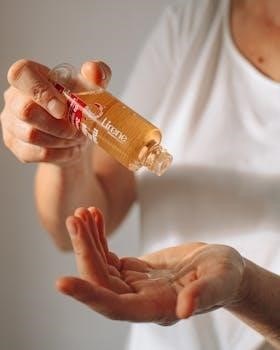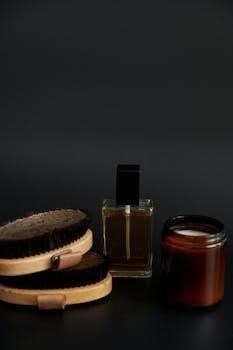MAM Bottle Self Steriliser Instructions⁚ A Comprehensive Guide
This comprehensive guide provides detailed instructions on how to safely and effectively self-sterilise your MAM bottles. We’ll cover everything from water measurement to microwave settings, ensuring a hygienic feeding experience.
MAM self-sterilising bottles offer a convenient solution for busy parents who prioritize hygiene. These innovative bottles are designed to be easily sterilised in a microwave, eliminating the need for a separate steriliser unit. This feature makes them ideal for travel and quick sterilisation at home. MAM bottles are made from high-quality, baby-safe materials, ensuring the well-being of your little one.
The self-sterilising process is simple and efficient, requiring only a small amount of water and a microwave. By following the correct instructions, you can effectively eliminate harmful bacteria from the bottle components. This ensures that your baby’s feeding equipment is clean and safe for use. The design also allows for easy assembly and disassembly, making cleaning a breeze. MAM’s self-sterilising bottles are a practical and reliable choice, combining convenience with the highest standards of hygiene for your baby.
Benefits of Self-Sterilising MAM Bottles
Self-sterilising MAM bottles offer a multitude of benefits for both parents and babies. The primary advantage is convenience; these bottles can be quickly sterilised in a microwave without needing a separate steriliser. This is especially useful for travel or when you’re short on time. The process is straightforward, requiring only a small amount of water and a few minutes in the microwave.
Hygiene is another key benefit. Self-sterilising ensures that bottles are free from harmful bacteria, promoting your baby’s health. The design of MAM bottles also simplifies cleaning and assembly. All components can be easily disassembled and washed, reducing the risk of residue buildup. Furthermore, MAM bottles are made from safe, BPA-free materials, giving parents peace of mind. The anti-colic design further enhances the feeding experience, reducing discomfort for your baby. Overall, MAM self-sterilising bottles provide a practical, hygienic, and safe feeding solution.
Step-by-Step Guide to Self-Sterilising MAM Bottles
To self-sterilise your MAM bottle effectively, begin by disassembling all the components⁚ the bottle base, valve, screw ring with teat, bottle body, and protective cap. Ensure all parts are clean before sterilising. Next, using the scale on the bottle lid, measure 20ml of cool, clean water. Pour the water into the bottle base, specifically into the white valve section.
Place the screw ring with the teat onto the bottle base containing the water. Then, position the bottle body on top of the screw ring, ensuring it rests securely but is not screwed down tightly. Finally, place the protective cap loosely on top of the bottle. Your bottle is now ready for self-sterilisation in the microwave. Follow the recommended microwave settings and sterilisation times based on your microwave’s wattage. After sterilisation, allow the bottle to cool down before disassembling and using it.
Water Measurement for Self-Sterilisation
Accurate water measurement is crucial for the effective self-sterilisation of MAM bottles. Using the incorrect amount of water can compromise the sterilisation process, potentially leaving harmful bacteria present, or it could damage the bottle itself. The recommended amount of water for self-sterilisation is precisely 20ml. This measurement ensures that enough steam is generated to thoroughly sanitise all bottle components during the microwaving process.
To measure the water accurately, use the scale provided on the MAM bottle lid. It is important to use cool, clean tap water for sterilisation. Avoid using distilled or softened water, as these may not produce the desired steam quality. Carefully pour the measured 20ml of water into the base of the bottle, ensuring it is placed directly into the white valve section; This precise water level is essential for safe and effective self-sterilisation.
Assembling the MAM Bottle for Self-Sterilisation
Proper assembly of the MAM bottle is essential for effective self-sterilisation. Ensure all bottle components are thoroughly cleaned and rinsed before assembly. Begin by placing the screw ring/collar with the teat onto the bottle base, which already contains the measured 20ml of water in the white valve section.

Next, carefully position the bottle body over the screw ring and teat assembly. It is crucial NOT to screw down the bottle body onto the base at this stage. The bottle body should rest loosely on top. Finally, place the protective cap on top of the bottle body. This cap helps to contain the steam generated during the sterilisation process.
Double-check that all components are correctly aligned and loosely fitted together. Avoid overtightening any parts, as this can prevent proper steam circulation and compromise sterilisation. The assembled bottle is now ready for microwaving according to the specified time and power settings. This careful assembly ensures the entire bottle is effectively sterilised.
Microwave Settings and Sterilisation Time
Selecting the correct microwave settings and sterilisation time is critical for effectively sterilising MAM bottles. The recommended settings depend on your microwave’s wattage. For microwaves ranging from 500 to 1000 watts, adhere to the specific sterilisation times outlined in the MAM bottle instructions.
It’s vital not to exceed the recommended wattage or sterilisation time, as this can damage the bottle or the microwave. Overheating can warp the plastic components, compromising their integrity and potentially releasing harmful chemicals. Conversely, insufficient sterilisation time may not eliminate all bacteria, posing a risk to your baby’s health.
Always consult the MAM bottle’s user manual for precise timing based on your microwave’s power. After sterilisation, allow the bottle to cool down inside the microwave for the recommended period before removing it. This cooling period ensures the steam dissipates safely and prevents burns. Remember, accurate settings are essential for safe and effective sterilisation.
Cooling Down After Sterilisation
Allowing sufficient cooling time after sterilisation is essential for safety and hygiene. Once the sterilisation cycle is complete, do not immediately remove the MAM bottle from the microwave. Instead, let it stand inside with the door slightly ajar. The recommended cooling time is typically around 10 minutes.
This period allows the superheated steam inside the bottle to gradually dissipate, preventing accidental burns from escaping steam when you open the microwave. Moreover, the cooling period aids in the sterilisation process, ensuring all surfaces remain sterile for longer.
Before handling the bottle, carefully remove it from the microwave, holding it upright to avoid spilling any residual hot water. It is best to pour away any remaining water carefully. Allow the parts to dry after shaking off any excess water. Remember to always wash your hands before handling sterilised components to maintain hygiene. Storing the bottle dry also prevents bacterial growth.
Safety Precautions During Self-Sterilisation
Prioritising safety is paramount when self-sterilising MAM bottles. Always ensure the bottle components are clean before beginning the sterilisation process. Using the bottle with sugar free food to avoid injury and tooth decay. Always check the temperature before feeding.
Never place the bottle in the microwave without water. Use the correct amount of water as indicated in the instructions, as too little water will not sterilise properly, and too much water could extend the sterilisation time or damage the bottle. When removing the bottle from the microwave, hold it upright to avoid spills. Allow the bottle to cool down before removing it from the microwave.
Always ensure that you always set the correct power and time on the microwave. Avoid using a microwave with a grill function, as the heat could damage the self-sterilising bottle. Finally, wash hands before handling the sterilised products, and always store the bottle dry. Prolonged contact with liquids can cause tooth decay.
Cleaning and Maintenance of MAM Bottles
Proper cleaning and maintenance are essential for hygiene and longevity of your MAM bottles. Before first use, wash all components separately in boiling water for 5 minutes to ensure hygiene. Disassemble all bottle parts for cleaning and sterilising. Assembled parts may damage bottles; Regularly wash the bottles and components in mild soapy water, then rinse thoroughly.

Use only soft bristle brushes or sponges, avoiding abrasive cleaning agents that can scratch the plastic. While dishwasher safe, food colorings may discolor components. Inspect all individual parts before each use and throw away at the first signs of damage. To avoid lime scale, pour away any surplus water and dry the appliance with a soft cloth.
For stubborn lime scale, diluted household vinegar can be used. Avoid direct sunlight or heat to prevent affecting product function. Store teats and vents in a dry, sealed container. Ensure valve is assembled correctly and the base of the bottle is firmly attached prior to filling.
Microwave Steriliser Usage (Alternative Method)
As an alternative to self-sterilisation, you can use a dedicated microwave steriliser. Fill the base of the microwave steriliser with water according to the manufacturer’s instructions. The amount of water and sterilisation time depend on the steriliser model and the number of bottles to be sterilised. Place the disassembled bottles and components inside the steriliser, arranging them flexibly on the levels provided. Ensure that the lid is securely closed.
Set your microwave to the correct power level and time, adhering to the recommended guidelines. Allow the microwave steriliser to cool down before removing it from the microwave. Be cautious when opening the steriliser after use, as hot steam can escape. Use tongs to remove and assemble the components, avoiding contamination.

After sterilisation, products stay sterile for up to 24 hours if kept closed. Air bubbles in bottles compromise sterilisation. Ensure the steriliser doesn’t touch the microwave walls. Filling with inaccurate water measures can damage the steriliser.
Electric Steriliser and Bottle Warmer Instructions
For an even more convenient sterilisation and warming solution, consider using a MAM electric steriliser and express bottle warmer. Before first use, clean all components and sterilise them in boiling water for 5 minutes. Always disassemble the bottles into their individual components for effective cleaning and sterilisation.
Follow the manufacturer’s instructions for filling the steriliser with water. Arrange the bottles, nipples, and other accessories inside the steriliser, ensuring they are properly positioned for steam circulation; Select the appropriate sterilisation cycle and allow the unit to complete its operation. After the cycle is finished, let the bottles cool down before handling them.
The MAM electric steriliser also functions as a bottle warmer; Refer to the user manual for specific instructions on warming bottles of different sizes and materials. Always check the food temperature before feeding your baby, and never overheat the contents. Remember to regularly descale the steriliser to maintain its optimal performance.
Troubleshooting Common Issues
Even with careful adherence to instructions, you might encounter some issues while self-sterilising your MAM bottles. One common problem is incomplete sterilisation, which can occur if the correct amount of water isn’t used or the microwave wattage is incorrect. Always ensure you’re using 20ml of water and the recommended microwave settings.
Another issue is bottles melting or warping. This usually happens when the bottles are exposed to excessive heat, either from too high a wattage or prolonged sterilisation time. Refer to the microwave settings and sterilisation time. If water is used up, stop the microwave immediately;
If you notice a persistent odour after sterilisation, it could be due to residue buildup. Ensure you’re thoroughly cleaning all bottle components before sterilising and using sugar-free food. Limescale buildup can also affect performance; descale regularly using diluted household vinegar. If problems persist, consult the MAM customer support.

